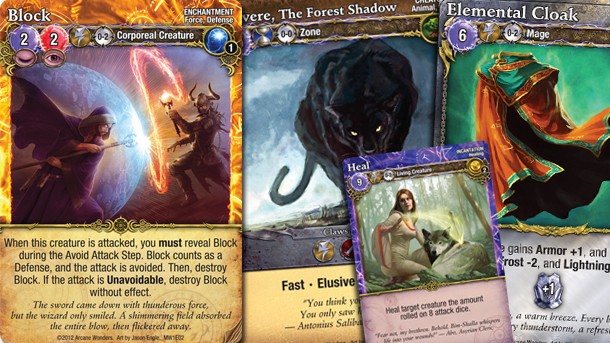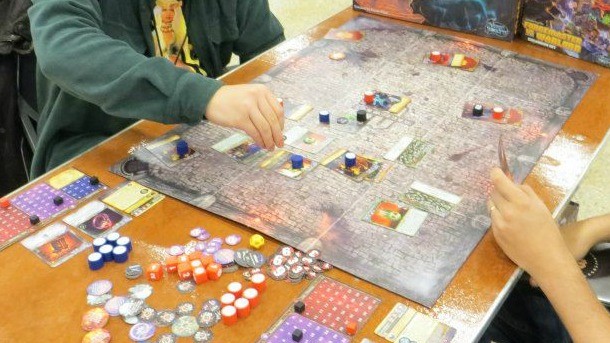Top Of The Table: Mage Wars

This month, we continue our series on highly recommended tabletop games with a look at Arcane Wonders’ Mage Wars, created by Bryan Pope. In recent months, I’ve highlighted some fun group games focused on storytelling, including Agents of SMERSH and A Touch of Evil. This month’s game maintains strong thematic elements, but puts the gameplay focus squarely on one-on-one competitive play.
Mage Wars draws on a number of familiar card game mechanics that may be familiar to players of games like Magic: The Gathering, including summoning creature cards and spells, spending mana, and attacking the enemy caster. However, unlike some of those titles, Mage Wars plays out on a strategic board, adding a tactical movement element, and the game is not built around an endless series of collectible cards in a deck – instead, each player has access to all their spells at any one time, and they’re all collected together in your own personal spellbook.
Getting Started
A single core set of Mage Wars is built to be played by two players, although the game supports larger team battles if you bring more sets to the table. Nonetheless, the heart of the experience is one-on-one play, where you’ll match wits (and spells) with a friend in a battle to prove the supremacy of your school of magic.
The most important element of game setup is preparing your spellbook. Each player is given an actual book filled with empty card sleeves and the identity of one of the playable mages. The core game includes the Beastmaster, Priestess, Warlock, and Wizard. Those identities help to shape the kind of spells you should choose to include in your spellbook; every spell is represented by a single card that can be slipped into your book, giving you access to it any time during the coming battle. A player could spend hours between play sessions customizing their spellbook; each spell has a cost to include in your arsenal, so you can play around to find the optimal configuration.

Luckily for new players, Mage Wars includes a list of cards to include for your first couple of games, as well as a standard listing for each of the four classes in subsequent bouts. As a result, if you’re not into the customization feature, or you just don’t have time for it, you’re still in for a good time.
Once you build your spellbook, the rest of setup is a cinch. A surprisingly big board represents the arena in which you’ll fight, and each player lays a card with a picture of their mage at opposite corners. This card placement is the first hints of a larger feature that sets Mage Wars apart. Rather than moving miniatures or cardboard standees around the board, you’ll slide your cards around from space to space. Summon a new creature, and that card goes onto the board, begins moving on its own, and remains in play until destroyed.
Finally, a straightforward numerical playmat is used to track your character’s stats, like mana and health, and some markers are used to indicate actions taken and status effects. Pull out the custom dice, and you’re good to go.
[Next up: How Mage Wars is played, and how long does it take to learn the game?]

Gameplay
Mage Wars has a quick-moving turn order that keeps the action hopping back and forth between players every few seconds, but turns get longer as the game goes on thanks to each player putting more spells and creatures into play. In the game sessions I played, I enjoyed the rapid give and take that occurs in a turn, and the way each player reacts to the other player’s spells and movements. In addition, because actions are clearly explained and easy to implement, no one player is ever left sitting for long periods during an exchange of turns.
The exception to that need to wait is before the action gets started, when each player is given a chance to plan ahead by pulling out two spell cards they plan to cast on their turn. This process can take a few minutes, especially since you have access to dozens of spells to pick between. Thankfully, this process is played concurrently by all players, so it’s rare that anyone is left sitting for long unless you’re playing with a particularly deliberate opponent.
While choosing your spells is sometimes time-consuming, it’s also my favorite element of Mage Wars, especially in comparison with a number of other tabletop card games. Many games leave players at the mercy of the card draw on a given turn, and matches can be won or lost on lucky pulls. Here, players have access to all their cards on any given turn, so it’s easy to plan carefully and implement a strategy from the start.
After choosing spells, players trade off casting and activating characters on the board, which increase in number as the game continues and more cards go out into play. Whether it’s your mage or some summoned ally, most characters can move one square and do a quick action, or stay in place for what is usually a more powerful action. Your mage him- or herself also gets some added options each turn, like the ability to don summoned equipment or cast extra quick spells before or after the main turn.
Battles play out through a roll of attack dice, and occasionally an extra status die roll that can apply additional effects. These exchanges play out quickly once you’re familiar with the game, but in early sessions, expect to spend some time looking up keywords and effects.
Play continues until one mage or the other has been killed, but that rarely happens before all sorts of interesting situations unfold on the board.

Complexity
All of the spell cards in Mage Wars have been designed for clarity and straightforward interactions with the rest of the game, but learning all the different types of spells available and how to best use them involves some investigation and time. I was three or four games in before I grasped the fundamentals.
Thankfully, Arcane Wonders has provided players a number of tools to help ease the transition. The rulebook is excellently organized, and includes an alphabetized list of all the game’s effects and keywords for easy reference during a game. Don’t know how an “Incorporeal” creature is affected by a “Burn” status? The codex has a quick answer, and more often than not that answer lines up with exactly how you think that situation would play out.
Mage Wars also includes starter rules to get players into the game quickly the first time they open the box. This Apprentice Mode uses fewer cards, and dramatically cuts down on the distinct powers for each mage class, so that everyone can be on an even playing field and help each other remember the rules.
Finally, in what is increasingly an expected norm for the tabletop industry, Arcane Wonders has an excellent set of online video tutorials to explain the basics of play.
Move past those first few matches, and Mage Wars emerges as a game of enormous strategic depth. Secret enchantment cards go into place on allies or enemies to be triggered at opportune moments. Conjured lairs offer new locations from which allied creatures can pour forth. Towering walls of thorn or fire surge up between spaces, blocking movement paths. Quick incantations dissolve an enemy’s prized equipment. Nearly every action in the game has multiple counters that can be deployed to turn the tide. No game I’ve ever played so aptly communicates the imaginative vision of two dueling casters, each pulling out all the stops to hold off their foe.
[Next up: An unfolding story through organized play, and where you can buy Mage Wars]

Theme and Story
The richly illustrated cards, varied character classes, and over 300 spell cards all help to give Mage Wars a clear identity, rooted in the best traditions of classic medieval fantasy. Spells interact with the board in the way you’d expect them to, and it’s easy to imagine the growing chaos of the arena as it erupts with spells and summoned monsters.
However, that strong sense of theme and place never extends to a more full-blown story in any traditional sense. When it comes right down to it, the game is about a single gladiator fight, albeit one between two spell-flinging magic-users.
For players hungry for a deeper sense of story from Mage Wars, you’ll want to hunt down one of the many organized play opportunities that Arcane Wonders has set up around the country. Not only do these organized play sessions offer chances to win new cards, but they also feed into an ongoing storyline for the world of Mage Wars. Players are given story points based on their participation and victories, and they can use those story points to vote on how the overall story of the game world will progress in future installments.
What else do I need to know?
The Mage Wars core game includes enough cards to create and customize spellbooks for each of the four classes, and still have plenty of cards left over for future tweaking. However, when you’re ready for more, Arcane Wonders already has the first of what is likely to be several character expansion packs available for purchase. The Forcemaster vs. Warlord Expansion Set brings two new mages into the mix, along with over 200 more cards. Like each of the base classes, the Forcemaster and Warlord each have their own specialties and abilities. For what it’s worth, the Forcemaster is my current favorite, mostly because she plays like a Jedi in all things but name.
Mage Wars is available for purchase directly from Arcane Wonders or at any number of online retailers including CoolStuffInc, Thought Hammer, or Amazon; most current listings hover around $40 for the core set, and under $30 for the first expansion. The game should also be available through most local hobby stores.
As tabletop games go, Mage Wars is a title that takes some time commitment before you truly excel. However, for such a deep and complex game, it’s remarkably welcoming to newcomers. For competitive players who occasionally find themselves with a single partner to play with, it’s an ideal choice that could keep you busy for a long time, and the high customization options assure that no two games need be alike. Smart design, tactical sophistication, and above all, a seamless implementation of the thematic concept of dueling mages, all make this a title that should not be missed by genre enthusiasts.
For more recommended tabletop games from Game Informer, check out write-ups on Ascension, Tannhauser, Castle Ravenloft, Yomi, Star Trek: Fleet Captains, Agents of SMERSH, or A Touch of Evil.

Get the Game Informer Print Edition!
Explore your favorite games in premium print format, delivered to your door.
- 10 issues per year
- Only $4.80 per issue
- Full digital magazine archive access
- Since 1991









